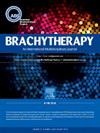Implementation of 3D image-guided brachytherapy for penile cancer: Impact of urethral dose on long-term morbidity
IF 1.7
4区 医学
Q4 ONCOLOGY
引用次数: 0
Abstract
Purpose
Interstitial brachytherapy is a conservative treatment approach for localized penile glans cancer. We report our experience with pulse dose rate interstitial brachytherapy (PDR-BT) in the treatment of penile cancer and evaluated urethral dose-volume constraints for clinical practice.
Methods and materials
Medical records of patients treated with PDR-BT for localized squamous cell carcinoma of the glans penis in our institution between July 2008 and February 2019 were reviewed. All patients underwent posthectomy followed by CT-guided PDR-BT. Urethral doses were calculated and predictors of urethral stenosis among various clinical and dosimetric characteristics were examined.
Results
65 patients were identified. Eight patients (12%) presented initially with inguinal lymph node metastasis. The median brachytherapy dose was 60 Gy (37–65 Gy). The median number of pulses was 150 pulses (87–175 pulses). With a median follow-up of 37 months (3–120 months), 12 patients (18.4%) had tumor local relapse. Three-year overall survival (OS) and disease-free survival (DFS) rates were 88.2% (95%CI: 79.7–97.7%) and 74.4% (95%CI: 63.9–86.6%) respectively. Twelve patients (20%) presented grade 2 painful ulceration resolving spontaneously and 13 patients (21.5%) experienced grade 2 meatal stenosis. No clinical or dosimetric factors correlated with painful ulceration were identified. The risk of meatal stenosis correlated with distal urethra D0.1cc (p = 0.0016) and D0.2cc (p = 0.0019) in multivariate analysis. The optimal cutoff for these constraints were 82 Gy (HR = 0.12, 95%CI: 0.04–0.38) and 79 Gy (HR = 0.19, 95%CI: 0.06–0.56) for D0.1 cc and D0.2 cc respectively.
Conclusions
This institutional experience shows that 3D PDR-BT could be a valid option for penile preservation. Dosimetric constraints for late distal urethral toxicity were identified.
三维影像引导下阴茎癌近距离放射治疗的实施:尿道剂量对长期发病率的影响。
目的:间质性近距离放射治疗是治疗局限性阴茎头癌的一种保守方法。我们报告了脉冲剂量率间质近距离放射治疗(PDR-BT)治疗阴茎癌的经验,并评估了临床实践中尿道剂量-体积限制。方法与材料:回顾性分析我院2008年7月至2019年2月间应用PDR-BT治疗阴茎龟头局限性鳞状细胞癌的病例。所有患者均行术后ct引导PDR-BT。计算尿道剂量,并检查各种临床和剂量学特征对尿道狭窄的预测。结果:共确诊65例。8例(12%)患者最初表现为腹股沟淋巴结转移。中位近距离放疗剂量为60 Gy (37 ~ 65 Gy)。脉搏中位数为150次(87-175次)。中位随访37个月(3 ~ 120个月),12例(18.4%)患者肿瘤局部复发。3年总生存率(OS)和无病生存率(DFS)分别为88.2% (95%CI: 79.7-97.7%)和74.4% (95%CI: 63.9-86.6%)。12例(20%)患者出现2级疼痛性溃疡自行消退,13例(21.5%)患者出现2级金属狭窄。未发现与疼痛性溃疡相关的临床或剂量学因素。多因素分析中,尿道远端狭窄风险与D0.1cc (p = 0.0016)、D0.2cc (p = 0.0019)相关。D0.1 cc和D0.2 cc的最佳临界值分别为82 Gy (HR = 0.12,95%CI: 0.04-0.38)和79 Gy (HR = 0.19,95%CI: 0.06-0.56)。结论:这一机构的经验表明,3D PDR-BT可能是阴茎保存的有效选择。确定了晚期远端尿道毒性的剂量学限制。
本文章由计算机程序翻译,如有差异,请以英文原文为准。
求助全文
约1分钟内获得全文
求助全文
来源期刊

Brachytherapy
医学-核医学
CiteScore
3.40
自引率
21.10%
发文量
119
审稿时长
9.1 weeks
期刊介绍:
Brachytherapy is an international and multidisciplinary journal that publishes original peer-reviewed articles and selected reviews on the techniques and clinical applications of interstitial and intracavitary radiation in the management of cancers. Laboratory and experimental research relevant to clinical practice is also included. Related disciplines include medical physics, medical oncology, and radiation oncology and radiology. Brachytherapy publishes technical advances, original articles, reviews, and point/counterpoint on controversial issues. Original articles that address any aspect of brachytherapy are invited. Letters to the Editor-in-Chief are encouraged.
 求助内容:
求助内容: 应助结果提醒方式:
应助结果提醒方式:


